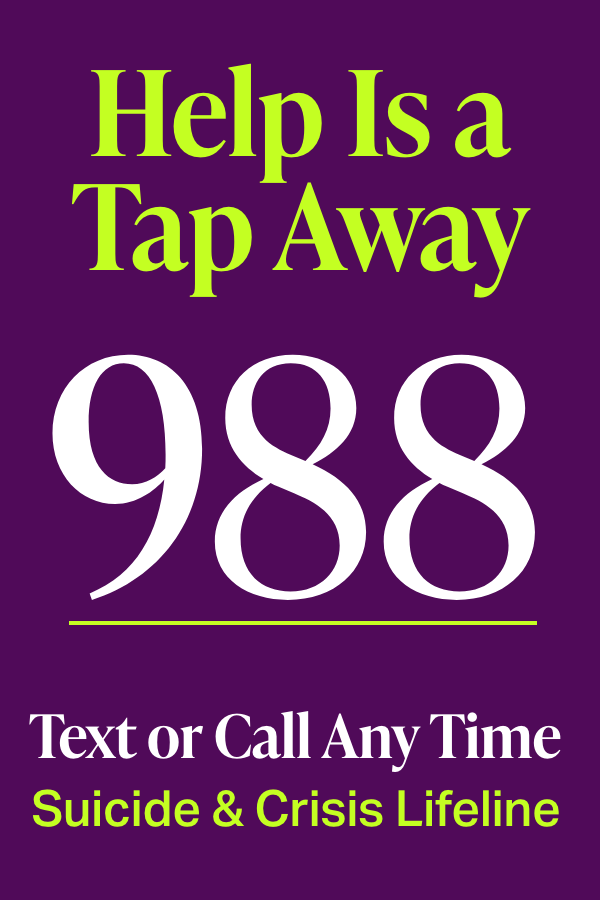You’re scrolling through social media and, (seemingly) suddenly, two hours have passed. What happened? According to researchers at the University of Washington, you might have been dissociating.
Which is only ironic because, thanks to social media, “dissociation” is suddenly the word du jour.
What is dissociation? It’s defined by the American Psychiatric Association as “disconnection between a person’s thoughts, memories, feelings, actions, or sense of [self].”
Dissociation is the latest mental health term to get the TikTok treatment, with 703 million videos using the #dissociation hashtag alone. And while the depictions it gets in 7-second videos aren’t always accurate, having the term move beyond clinical circles and into more general lexicon can have its positives.
Dissociation is, in essence, a coping mechanism, but it can occur both in harmless, everyday situations…and as a result of serious trauma. To learn the basics, we spoke with Rebeca Scherman, Psy.D., a clinical psychologist based in New York City and expert on trauma and dissociation. Here are five things to know.
1. Dissociation is a temporary escape from reality
It’s tricky to pin down the D word, because different people experience dissociation in very different ways. Many mental health experts view it on a continuum, explains Dr. Scherman. “There’s healthy dissociation on one end of the spectrum, and what we call pathological dissociation on the other, and there’s a big range in between,” she says.
GOTTA READ: Emotionally Reactive? 4 Types of Therapy to Tame Your Outbursts
Healthy dissociation is your brain’s way of taking a break from triggers like stress or boredom. Hypnosis can put you in a dissociative state, but so can drug use, Dr. Scherman says; eating disorders and self-harm behaviors are other unhealthy ways people dissociate.
Wherever the dissociation lives on the spectrum, however, the behavior itself temporarily disconnects people from their feelings and thoughts, and sometimes even their physical bodies. Behaviors like self-harm can act “as a passage or gateway” into dissociation, says Dr. Scherman, helping contribute to that sense of disconnection.
2. Most people dissociate from time to time
About 75 percent of us will dissociate at least once in our lives, science reveals. Common and harmless forms of dissociation include daydreaming or losing yourself in a book or movie.
“Or maybe you don’t remember taking your usual highway exit because your mind was somewhere else,” Dr. Scherman says. (Also called “highway hypnosis,” this is when you go into a state of “automaticity,” she says, where you perform an action without consciously thinking about it because your mind was elsewhere.)
3. Dissociative disorders are a different thing
They’re much more rare, affecting an estimated 2 percent of Americans, and a diagnosis means that dissociation is causing major problems in your daily life. Examples of dissociative disorders found in the Diagnostic and Statistical Manual of Mental Disorders (DSM), the guidebook of mental health conditions, include:
- Dissociative amnesia. This is marked by an inability to remember important details about yourself. Most commonly, the amnesia is tied to a traumatic event or time period. The amnesia can last for just a few minutes or for many years. One type of dissociative amnesia is dissociative fugue, in which people also travel or wander suddenly and unexpectedly. They may wake up in an unfamiliar place with no recollection of how they got there.
- Depersonalization/derealization disorder. This can manifest as a feeling of being outside your own body, or by feeling that the people and things around you aren’t real. These sensations usually begin before the age of 16 and tend to be recurring. People who experience these feelings are aware that something unusual is going on—they generally don’t lose touch with reality (that’s what distinguishes this from something like a psychotic break, Dr. Scherman says).
- Dissociative identity disorder (DID). Formerly known as multiple personality disorder, DID is a complex condition that we don’t comprehend all that well. “Even mental health professionals often struggle to understand and diagnose it, because they’re not taught enough about complex trauma in their graduate training programs,” Dr. Scherman says. DID is characterized by having two or more distinct personality states with different behaviors, thoughts, and voices. People with DID also have ongoing gaps in memory.
The authors of a 2022 study about dissociative disorders study said they hoped their work would help reduce not just stigma, but misdiagnosis. “We hope it will increase awareness of dissociative symptoms—and that, ultimately, clinicians will be more likely to assess for and consider these symptoms, and to connect patients with timely and appropriate treatment,” said co–senior author Milissa Kaufman, M.D., Ph.D., the director of the Dissociative Disorders and Trauma Research Program at McLean Hospital.
Sign up for our free newsletter
Legit tips and cool copes, delivered straight to your inbox.
By completing this form you are signing up to receive our emails and can unsubscribe anytime.
4. Dissociation is often linked to past trauma
“Most of us are born with the ability to dissociate; some people are more capable of it than others,” Dr. Scherman says. “And then the experiences we have in life can reinforce that skill, sometimes in pathological ways. For example, if a child is being abused and they need a way to disconnect from what’s happening at home so they can go to school, they’re going to grow that dissociation muscle.” Dissociation caused by trauma has a bigger impact in women, confirmed that 2022 study, published in the journal Neuropsychopharmacology.
GOTTA READ: 16 Best Weighted Blankets That Aren’t “Mental Illness Gray”
For a person going through a traumatic experience, dissociation can be a powerful survival tool. “Psychiatrist Dr. Frank Putnam described dissociation as the escape when there is no escape,” Dr. Scherman explains. “It can help people survive unimaginable circumstances involving danger and abuse. The brain is protecting the person from fully experiencing what is happening in the moment, because it’s just too much,” she says.
While this can help in real time, over the long term, severe dissociation alters a person’s normal fear response. “We all go through the world scanning for patterns and assessing whether situations are safe or dangerous,” says Dr. Scherman. “But for somebody with a trauma history, this turns into either hyperarousal or hypoarousal.” Which means (in Cliff’s Notes form): being excessively concerned or not concerned enough.
A combat veteran, for example, may be highly sensitive to potential dangers around them and prone to panic attacks or flashbacks, Dr. Scherman says. You’ve heard of the fight-or-flight response, yes? That’s what hyperarousal is.
In hypoarousal, meanwhile, your body’s warning system has switched off completely. Your nervous system is so packed with crap, it’s too much to handle, and you can become numb—and more likely to put yourself in dangerous situations. This is also called the freeze response.
“Because people are shut down, they can’t assess the dangers around them in a realistic fashion. Their system is totally overwhelmed,” Dr. Scherman says. “The way I talk about it with my patients is, when you have experienced trauma or dangerous situations, you’ve learned through living life that danger could lurk around every corner. So you develop an early warning system.”
It may seem counterintuitive, but this is why dissociation in the form of hypoarousal can lead people to check out and, scarily, end up in sketchy circumstances.
5. Healing from a dissociative disorder starts with trust
“Some trauma processing treatments, like EMDR [eye movement desensitization and reprocessing] therapy, are in fashion right now,” Dr. Scherman says. But there are no quick fixes when it comes to healing from significant trauma, she adds.
“It is contraindicated for somebody who has experienced trauma in childhood and has complex PTSD to just go do EMDR. That’s the worst thing somebody could do for a number of reasons,” says Dr. Scherman. “Dissociation is protective. You don’t go drilling and blast somebody’s defenses. It can completely dysregulate somebody. I’ve seen people end up in the hospital.”
The right way to start, then? Find a therapist who understands developmental trauma and PTSD, “who you can begin to even consider building trust with,” Dr. Scherman says. Jumping straight into one particular treatment could backfire.
“Somebody who has experienced trauma at that level in childhood does not trust another person. It doesn’t work to try to bypass that and pretend that’s not the first issue to address—you need to build the foundation before you build the house,” says Dr. Scherman. As the two of you establish a healthy working relationship, you can map out the best path forward.
READ NEXT: Is Your Friend (or Ex or Boss) a Narcissist? Spot the Signs
Social Media as Dissociation: https://www.washington.edu/news/2022/05/23/people-enter-a-dissociative-state-when-using-social-media/
Dissociation Definition: https://www.nami.org/About-Mental-Illness/Mental-Health-Conditions/Dissociative-Disorders
Common Forms of Dissociation: https://www.psychiatry.org/patients-families/dissociative-disorders/what-are-dissociative-disorders
Automaticity: https://www.sciencedirect.com/science/article/abs/pii/B0080430767017472
Percentage of People Who Will Dissociate: https://pubmed.ncbi.nlm.nih.gov/15022041/
Percentage of Those With Dissociative Disorders: https://my.clevelandclinic.org/health/diseases/17749-dissociative-disorders
Examples of Dissociative Disorders (1): https://www.psychiatry.org/patients-families/dissociative-disorders/what-are-dissociative-disorders
Examples of Dissociative Disorders (2): https://www.nami.org/About-Mental-Illness/Mental-Health-Conditions/Dissociative-Disorders
Dissociative Fugue: https://my.clevelandclinic.org/health/symptoms/22836-dissociative-fugue
Study on Dissociation: https://www.nature.com/articles/s41386-022-01468-1
Quote from Study Author About Dissociation: https://neurosciencenews.com/dissociation-brain-21780/
Hyperarousal and Hypoarousal: https://www.nicabm.com/trauma-how-to-help-your-clients-understand-their-window-of-tolerance/







